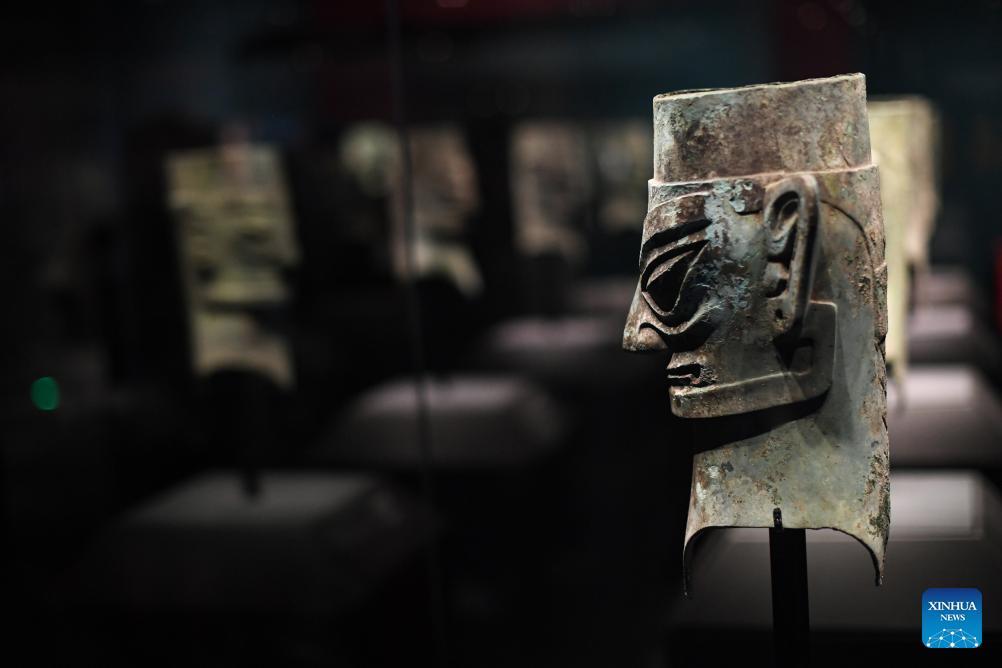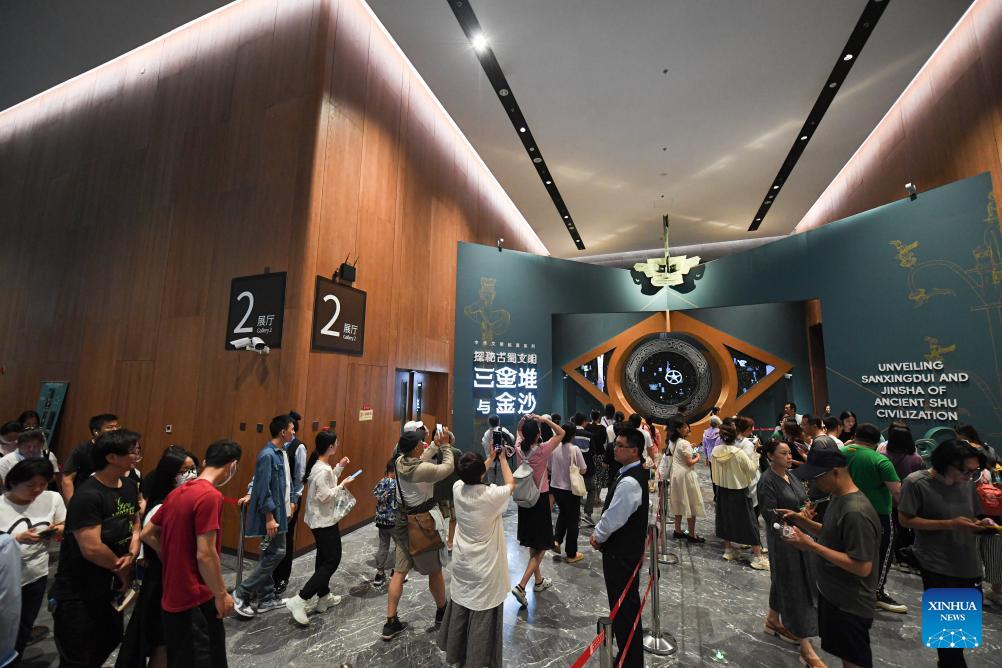
 0 Comment(s)
0 Comment(s) Print
Print E-mail China Daily, July 8, 2024
E-mail China Daily, July 8, 2024

This photo taken on June 27, 2024 shows a bronze exhibit during an exhibition named "Unveiling Sanxingdui and Jinsha of Ancient Shu Civilization" at the Grand Canal Museum of Beijing, in Beijing, capital of China. With a total of 265 pieces of relics featuring ancient Shu civilization, the exhibition kicked off here on Thursday and will last until Oct. 10. (Xinhua/Chen Zhonghao)
Scorching weather and its location far from downtown Beijing are not proving to be obstacles to people's enthusiasm for admiring the brilliance of ancient cultures.
Over the last two weekends, visitors have had to stand in long lines for hours on end to enter the Capital Museum East Branch to see artifacts from remarkable Bronze Age civilizations that flourished over 3,000 years in present-day Sichuan province.
The widely anticipated exhibition, Unveiling Sanxingdui and Jinsha of Ancient Shu Civilization, which opened on June 27 and which will run through to Oct 10, has placed 265 artifacts on display and shows the efforts over the last century to decode a distant past.
The Sanxingdui site in Guanghan was discovered in the 1920s, but what really amazed the world was the milestone 1986 discovery of two pits, presumably used for sacrificial ceremonies. Exotic-looking bronze masks, statues and gold artifacts ushered people into a world full of romance and imagination. The Jinsha site, discovered in 2001 in the provincial capital of Chengdu, is famed for its exquisite bronze, jade, stone relics and numerous ivory tusks.
Thanks to the two sites, ancient Shu civilization was able to emerge from mythology and literature to yield its treasures and character.
"Through tireless exploration and the generational efforts of archaeologists, the image of ancient Shu civilization, represented by the Sanxingdui and Jinsha cultures, is becoming increasingly clear," says Gao Hongqing, curator of the exhibition.
Nevertheless, the open-ended explanations on the artifacts on display demonstrate that the ongoing exploration of ancient Shu civilization still has a way to go.
As the bronze masks, human figures with protruding eyes, bronze wheel, and gold scepter on display show, the groundbreaking 1986 discovery at Sanxingdui leaves many issues unanswered. A new round of excavations between 2020 and 2022, which revealed six more "sacrificial pits", raised even more questions.
Tang Fei, deputy director of the Sichuan Provincial Cultural Relics and Archaeology Research Institute, says that about 60 of the exhibits in the ongoing display come from this new round of excavation, which led to the unearthing of more than 17,000 artifacts, including 4,800 that were mostly intact.
The bronze statue, depicting a man kneeling, twisting his body and clasping his hands together, was widely covered by the media after it was found in Sanxingdui in 2021, but visitors to the exhibition in Beijing may still wonder what exotic ceremony he is involved in.
Another bronze statue, with the body of a dragon, head of a tiger, and a bird resting on the base, also arouses curiosity about its use.
"Visitors can develop their own explanations," Gao says. "They may even inspire our own studies, as well."
Yu Jian, deputy director of the Sanxingdui Museum, says the ongoing exhibition displays the new mindset toward artifact restoration, as even damaged items can convey a great deal of information.
Despite their initially strange appearance, the Shu artifacts also demonstrate close links and frequent interaction with other regions in the rest of modern-day China, particularly in the middle and lower reaches of the Yangtze River, Gao says.
For example, a jade cong, a square tube with a circular bore, is typical of both Sanxingdui and Jinsha, but can be traced back to the Liangzhu Culture, which existed 5,300 to 4,300 years ago in modern-day Zhejiang province, nearly 2,000 kilometers away. Some bronze vessels from the sites also feature elements typical of the central Shang Dynasty (16th century-11th century BC).
"They provide significant evidence for a profound understanding of the diverse and integrated origins and development of Chinese civilization," Gao says.
"Regarding Sanxingdui and Jinsha, what moves us so deeply is not only the beauty, awe and mystery of the objects, but also the people themselves and their rich expression of self through materials like bronze, gold and jade," he says. "This expression embodies the commonality of the era and the individuality of regional culture blending tradition with innovation."
The Beijing event is the third major exhibition of recently excavated artifacts from Sanxingdui outside its home, after exhibitions in Hong Kong and Shanghai. It also lifts the curtain on a series of exhibitions tracing early-stage Chinese civilizations at the Capital Museum.

This photo taken on June 27, 2024 shows the scene of an exhibition named "Unveiling Sanxingdui and Jinsha of Ancient Shu Civilization" at the Grand Canal Museum of Beijing, in Beijing, capital of China. With a total of 265 pieces of relics featuring ancient Shu civilization, the exhibition kicked off here on Thursday and will last until Oct. 10. (Xinhua/Chen Zhonghao)